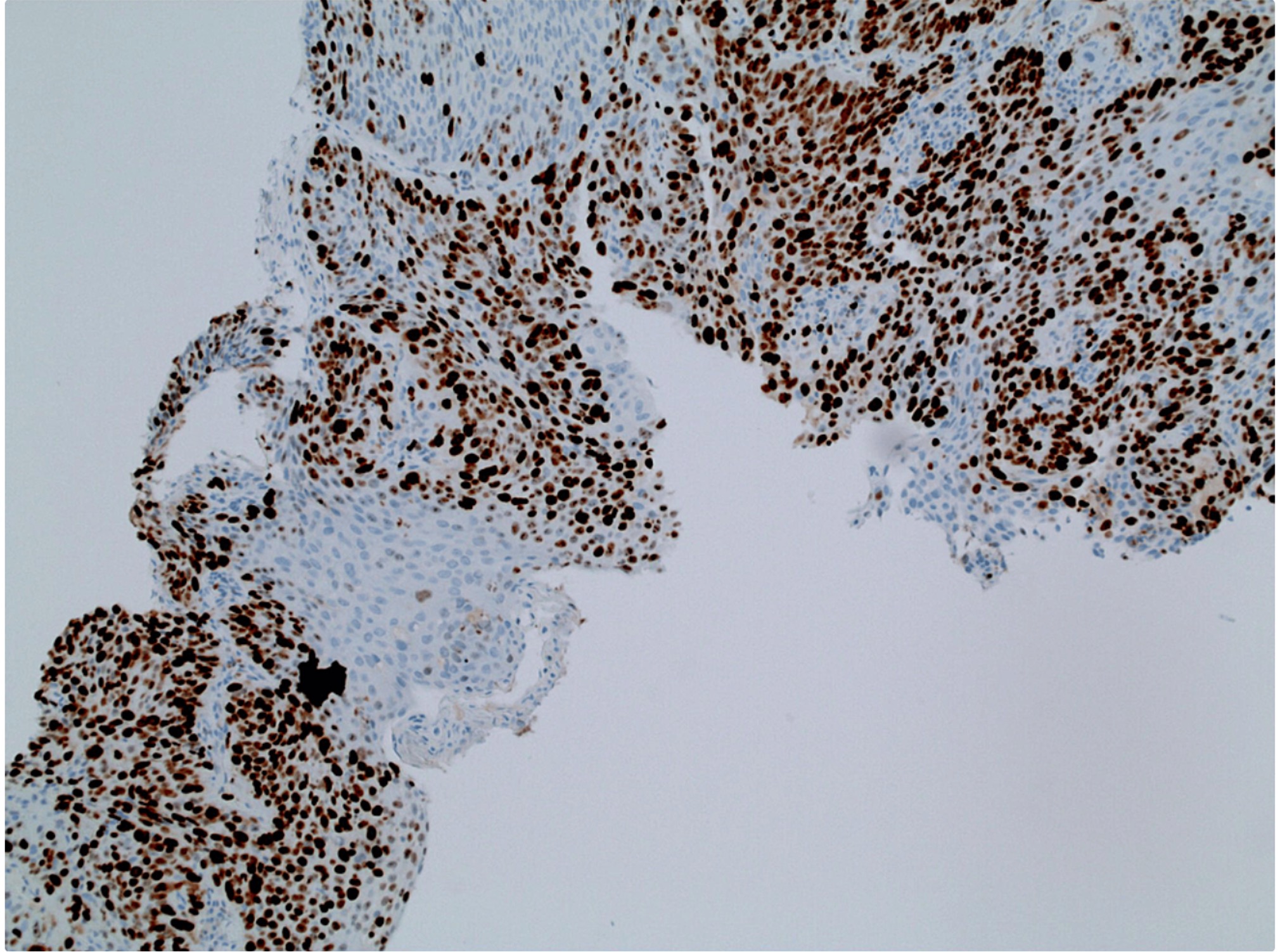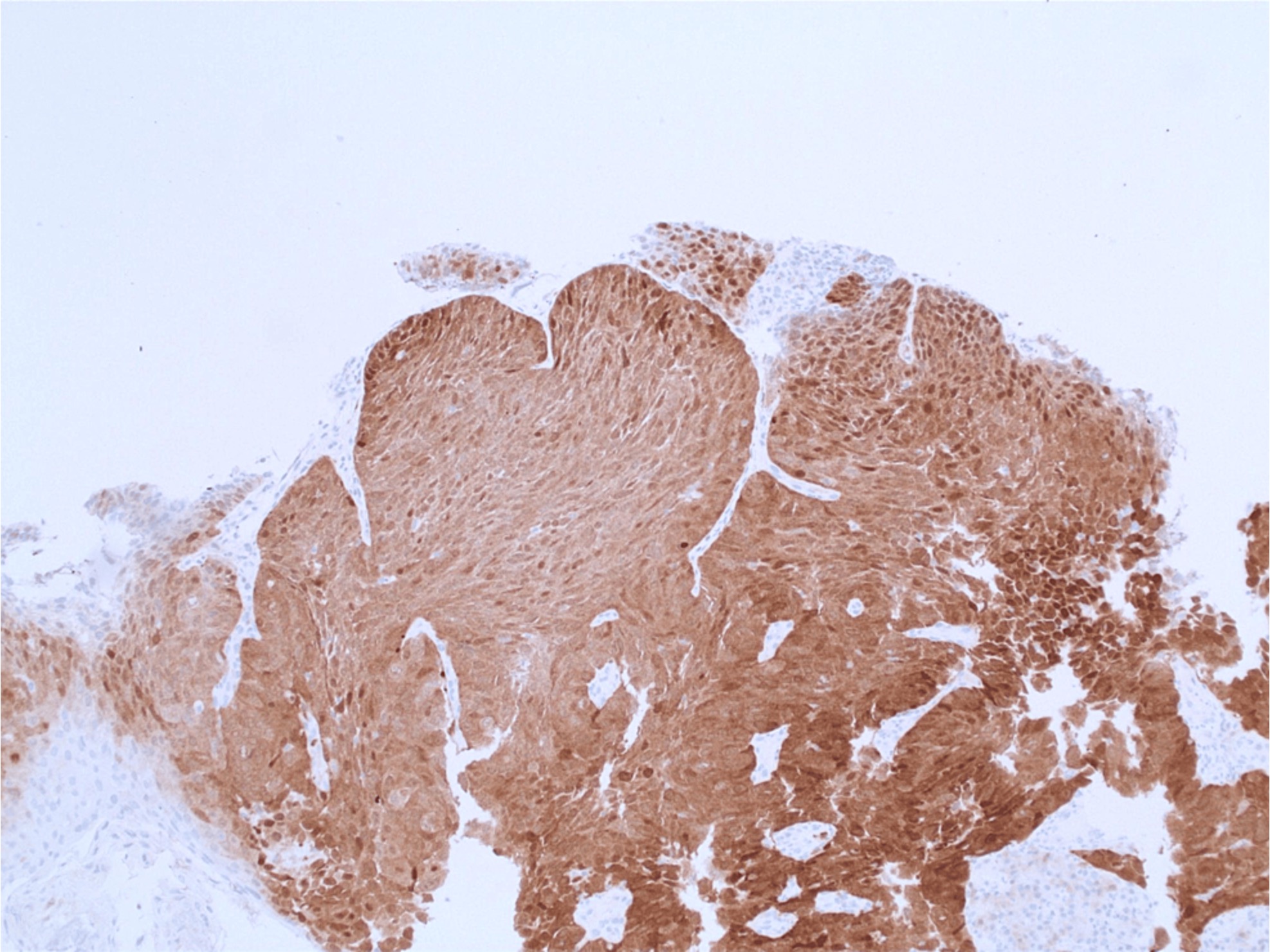Sunday Poster Session
Category: Esophagus
P0762 - Esophageal Intraepithelial Neoplasia Associated With High-Risk HPV in a Patient With Refractory Esophagitis
Sunday, October 26, 2025
3:30 PM - 7:00 PM PDT
Location: Exhibit Hall

Adlin Lawrence, MD
Orlando VA Medical Center and UCF/HCA Greater Orlando
Kissimmee, FL
Presenting Author(s)
Adlin Lawrence, MD1, Joane Titus, MD1, Alexandra Tucker, BS2, Jorge Restrepo, MD3, Seela Ramesh, MD2
1Orlando VA Medical Center and UCF/HCA Greater Orlando, Kissimmee, FL; 2University of Central Florida College of Medicine, Orlando, FL; 3Orlando VA Medical Center and UCF/HCA Greater Orlando, Orlando, FL
Introduction: Esophageal intraepithelial neoplasia (EIN) is a premalignant lesion that can progress to esophageal squamous cell carcinoma (SCC). While well-known risk factors include gastroesophageal reflux disease (GERD), tobacco use, and alcohol consumption; the role of human papillomavirus (HPV) in the pathogenesis of EIN remains under-recognized. We present a case that highlights the importance of considering EIN in the differential diagnosis for persistent esophagitis, especially in patients with concurrent HPV-related malignancy.
Case Description/
Methods: A 56-year-old male with a history of GERD and remote tobacco use presented with ongoing dysphagia, heartburn, and odynophagia despite high-dose proton pump inhibitor therapy and lifestyle modifications. Physical examination revealed a leukoplakic lesion on the right lateral tongue, confirmed via partial glossectomy to be invasive keratinizing SCC (pT1, G2, negative margins). Subsequent esophagogastroduodenoscopy (EGD) revealed mild esophagitis without Barrett’s esophagus. Biopsies from the mid-esophagus demonstrated EIN. Immunohistochemical staining of the esophageal biopsy showed strong nuclear and cytoplasmic positivity for p16 and Ki-67 in the middle two-thirds of the squamous epithelium, consistent with high-risk human papillomavirus (HPV) involvement. Workup was negative for HSV, CMV, and eosinophilic esophagitis. The patient was referred for endoscopic mucosal resection and ablation therapy.
Discussion: While HPV is a well-known risk factor for oropharyngeal cancer, its role in esophageal squamous pathology—specifically EIN—is emerging. EIN represents a precancerous lesion that may progress to esophageal SCC. The patient’s esophageal biopsy revealed EIN with p16 and Ki-67 positivity, consistent with high-risk HPV involvement. This suggests a field effect of HPV-induced dysplasia involving both the oropharynx and esophagus. Meta-analyses report HPV-16 in up to 22% of esophageal SCCs. Case reports have demonstrated regression of EIN with early interventions like RFA, highlighting the importance of early detection. This case highlights the importance of considering EIN in the differential diagnosis for persistent esophagitis. Persistent esophagitis symptoms should prompt evaluation for alternative etiologies like EIN, particularly in patients with concurrent HPV-related malignancies.
Further research is needed to better understand the relationship between HPV and EIN in the esophagus and to develop targeted prevention and treatment strategies.

Figure: Figure 1: (EIN) KI-67 positive immunohistochemical staining within 2/3 of the squamous epithelium (magnification: 400x)

Figure: Figure 2: (EIN) P16 positive immunohistochemical staining within 2/3 of the squamous epithelium (magnification: 400x)
Disclosures:
Adlin Lawrence indicated no relevant financial relationships.
Joane Titus indicated no relevant financial relationships.
Alexandra Tucker indicated no relevant financial relationships.
Jorge Restrepo indicated no relevant financial relationships.
Seela Ramesh indicated no relevant financial relationships.
Adlin Lawrence, MD1, Joane Titus, MD1, Alexandra Tucker, BS2, Jorge Restrepo, MD3, Seela Ramesh, MD2. P0762 - Esophageal Intraepithelial Neoplasia Associated With High-Risk HPV in a Patient With Refractory Esophagitis, ACG 2025 Annual Scientific Meeting Abstracts. Phoenix, AZ: American College of Gastroenterology.
1Orlando VA Medical Center and UCF/HCA Greater Orlando, Kissimmee, FL; 2University of Central Florida College of Medicine, Orlando, FL; 3Orlando VA Medical Center and UCF/HCA Greater Orlando, Orlando, FL
Introduction: Esophageal intraepithelial neoplasia (EIN) is a premalignant lesion that can progress to esophageal squamous cell carcinoma (SCC). While well-known risk factors include gastroesophageal reflux disease (GERD), tobacco use, and alcohol consumption; the role of human papillomavirus (HPV) in the pathogenesis of EIN remains under-recognized. We present a case that highlights the importance of considering EIN in the differential diagnosis for persistent esophagitis, especially in patients with concurrent HPV-related malignancy.
Case Description/
Methods: A 56-year-old male with a history of GERD and remote tobacco use presented with ongoing dysphagia, heartburn, and odynophagia despite high-dose proton pump inhibitor therapy and lifestyle modifications. Physical examination revealed a leukoplakic lesion on the right lateral tongue, confirmed via partial glossectomy to be invasive keratinizing SCC (pT1, G2, negative margins). Subsequent esophagogastroduodenoscopy (EGD) revealed mild esophagitis without Barrett’s esophagus. Biopsies from the mid-esophagus demonstrated EIN. Immunohistochemical staining of the esophageal biopsy showed strong nuclear and cytoplasmic positivity for p16 and Ki-67 in the middle two-thirds of the squamous epithelium, consistent with high-risk human papillomavirus (HPV) involvement. Workup was negative for HSV, CMV, and eosinophilic esophagitis. The patient was referred for endoscopic mucosal resection and ablation therapy.
Discussion: While HPV is a well-known risk factor for oropharyngeal cancer, its role in esophageal squamous pathology—specifically EIN—is emerging. EIN represents a precancerous lesion that may progress to esophageal SCC. The patient’s esophageal biopsy revealed EIN with p16 and Ki-67 positivity, consistent with high-risk HPV involvement. This suggests a field effect of HPV-induced dysplasia involving both the oropharynx and esophagus. Meta-analyses report HPV-16 in up to 22% of esophageal SCCs. Case reports have demonstrated regression of EIN with early interventions like RFA, highlighting the importance of early detection. This case highlights the importance of considering EIN in the differential diagnosis for persistent esophagitis. Persistent esophagitis symptoms should prompt evaluation for alternative etiologies like EIN, particularly in patients with concurrent HPV-related malignancies.
Further research is needed to better understand the relationship between HPV and EIN in the esophagus and to develop targeted prevention and treatment strategies.

Figure: Figure 1: (EIN) KI-67 positive immunohistochemical staining within 2/3 of the squamous epithelium (magnification: 400x)

Figure: Figure 2: (EIN) P16 positive immunohistochemical staining within 2/3 of the squamous epithelium (magnification: 400x)
Disclosures:
Adlin Lawrence indicated no relevant financial relationships.
Joane Titus indicated no relevant financial relationships.
Alexandra Tucker indicated no relevant financial relationships.
Jorge Restrepo indicated no relevant financial relationships.
Seela Ramesh indicated no relevant financial relationships.
Adlin Lawrence, MD1, Joane Titus, MD1, Alexandra Tucker, BS2, Jorge Restrepo, MD3, Seela Ramesh, MD2. P0762 - Esophageal Intraepithelial Neoplasia Associated With High-Risk HPV in a Patient With Refractory Esophagitis, ACG 2025 Annual Scientific Meeting Abstracts. Phoenix, AZ: American College of Gastroenterology.
